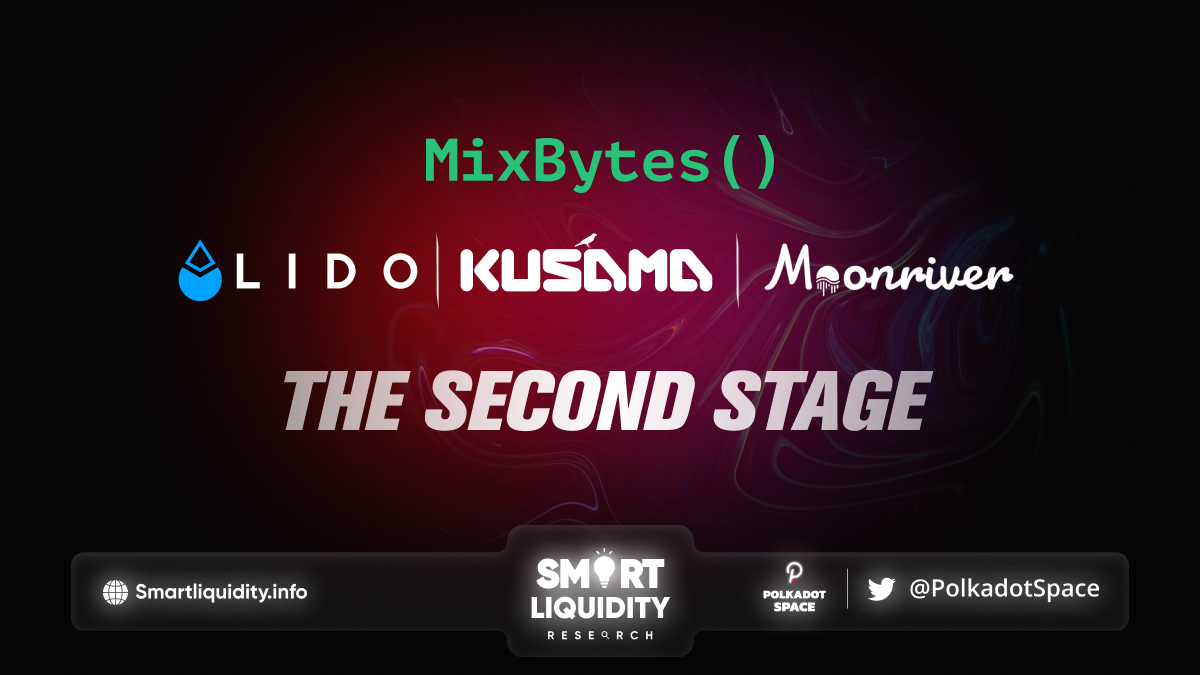Mixbytes Has Announces The Upgrades To The Second Stage


Mixbytes are excited to announce that they are ready for Lido Liquid Staking For Kusama Upgrades To The Second Stage.
Second Stage parameters:
- Uncapped stake and number of validator nodes
- Dynamic nomination model to increase annualized reward rate, or Annual Percentage Rate (APR) even more
- Launch of decentralized reward oracles
- Multisigs to control contract updates
Accomplished
Staking Rewards Performance:
Kusama delegation
14.6%* APR;
Kusama Network;
stakingrewards.com/earn/kusama/
Lido KSM staking
>24%* APR;
Moonriver Network;
kusama.lido.fi
Karura
19.9%* APY
Karura Network;
apps.karura.network/lksm
Development — bug fixes and optimizations
TL;DR (for more details see github.com/mixbytes/lido-dot-ksm ):
- They have their own RelayEncoder implemented and ready for cases when Moonbeam or Moonriver can’t upgrade it as fast as we need for uninterrupted XCM work.
- Withdrawal smart contract Fast track fixed. That means deposited funds go immediately to withdrawal smart contract in case ledgers must return some funds from Relay Chain to parachain.
- Function for XCM call for transferring funds from Relay Chain to parachain was updated.
- Withdrawal smart contract incorrect roundings bug fixed.
- Ledger renomination changed to batchable execution.
- The bytecode size of core smart contracts was reduced.
Decentralization efforts
What do the oracles do?
Decentralized reward oracles were released with 3/4 consensus on rewards and slashing amounts. If an oracle reports a more than 30% reward or slashing amount change compared to the previous result it will be ignored and the team will receive a report. Oracles are run independently by Lido, Moonriver, and Mixbytes.
Multisigs to control contract updates (MixBytes+Lido)
They have decentralized decision-making on smart contract updates approvals to several parties. There is a Gnosis Safe Multisig fork in the Moonriver key provided for each relevant role in Lido and Mixbytes.
Single superuser role was removed while implementing multisig, hence leaving no chance to manipulate the contract without all the respective parties participation.
How the dynamic nomination model works
Abstract
General principles
Transparency
Validator choice algorithm should be not just only transparent itself, but also based on public and provable data for each era. Era is a period of time during which there is a specific set of active validators: support.polkadot.network/support/solutions/articles/65000168050-what-is-an-era– . Here is the data we gather and calculate for each validator and era:
- Era points
- APR
- Stake amount
- Nominators list
- Slashing
- Payout rate
Gathered data is aggregated and used to build several metrics for different time periods:
- Operational: last block
- Short-term: ~1 week
- Mid-term: ~1 month
- Long-term: ~6 months
Then the scoring model considers dynamical changes of validators’ performance, e.g.:
- Operational data lets us detect oversubscribing, fees increase and slashing.
- Short-term data will show us if some relatively good validator in the long-term goes down or starts to lack in performance.
- Mid- and long-term data will hedge us from choosing validators who show good performance in the short-term but might be unstable in the long run.
APR maximization
APR maximization mechanics are based on validator scores described above. Lido will renominate validators as short-term parameters changed, so that we are up to date with new scores each week.
According to our short-term and long-term simulations and also according to the rules guide.kusama.network/docs/learn-phragmen/ of the Phragmén algorithm we nominate 3 validators from each ledger.
Nominating less than 3 validators leads to the risk of nominating a validator not elected to the active set. Being in an active set means that a validator has been elected to produce blocks this era (link). And not producing blocks means you will not earn any rewards for that era ( https://wiki.polkadot.network/docs/learn-staking-faq#nominated-validators-not-in-the-active-set ).
Having more than three validators leads to lower average APR in the available validator list left.
The next thing that we consider in choosing nominations amount on each validator is era points randomness. According to our simulation result, if we renominate validators every 7 days, then fewer nominated validators on each ledger leads to higher APR.
Algorithm for selecting validators
1. Filter out only validators open to the nomination.
2. Change nomination for ledgers immediately if the validator received a slash, increased commission, is not in the active set, validator calls kick for our nominator, or validator is kicked. We also have team notifications on each renomination case for manual review if needed.
3. For every era for each validator calculate APR for a week, month, year using the following equation:


era[i].commission – validator commission for i-th era;
era[i].rewards – validator rewards for i-th era;
era[i].otherStake – validator nominated stake for i-th era;
erasPerYear – eras amount in year.
4. Calculate validator activity ratio (e.g. if a validator was in active set in 8 eras for last 16 eras, then its activity ratio is 50%).5. Calculate average era points for validator for eraRange.
6. Calculate aggregated metric for each validator:
metric = (aprWeek + 3 ∗ aprMonth + aprYear) ∗
(2 ∗ activityWeek + activityMonth + activityYear) / 100 – 10¹⁸ ∗ sumSlashing,
where apr = metric mentioned in (1) per week, month, year
activity = metric mentioned in (2) per week, month, year
sumSlashing = cumulative slashing that validator received for all time
7. Determine best validators according to the aggregated metric;
8. Select top N * 3 validators for nomination, where N – ledgers amount;
9. For ledger[i] nominate validator[i], validator[i + N], validator[i + 2 * N];
10. Create a proposal for renomination in multisig.
Slashing hedging
Validators in the Kusama relay chain might be slashed due to different reasons starting from unavailability to double signing. Lido should minimize that risk despite slashing occurring rarely.
Their hedging strategy is based on stake diversification, which means we distribute pooled stake to several nominators or staking ledgers. We won’t choose a validator that once was slashed.
The amount of staking ledgers changes proportionally to pooled stake. We use optimal total stake on one ledger equal to 5,000 KSM. Kusama market cap = 12,000,000 KSM, current staked amount = 43% of market cap → 12,000,000 * 0.43 = 5,160,000 KSM, active validators set consist of 1,000 validators → optimal ledger stake 5,160,000 / 1000 ~ 5,000 KSM. This means if the ledger has more than 5,000 KSM in stake, then it starts to underperform. Therefore, if Lido’s total stake is greater than 20,000 but less than 25,000 we will use 5 ledgers.
That approach allows us to minimize slashing risk, e.g. let’s assume that we have 5 ledgers with the same stake and there are no intersections between nominated validators across them so if one of the ledgers gets slashed rewards from other ledgers will cover/minimize slashed losses.
For example, in one era we have 5 active ledgers with an active stake of 4,500 KSM and one of the ledgers nominates to the validator, which was slashed in the current era. According to our current APR = 25% we will receive as rewards 4,500 * 4 * 0.25 / 365 = 12.3 KSM. And as for one ledger let’s assume that the nominated validator goes offline, thus causing a 1% unresponsiveness slash to their nominators then 4,500 * 0.01 = 45 KSM will be slashed. In this case, era losses will be 45 – 12.3 = 32.7 KSM. If we use only one ledger, then losses will be 4,500 * 5 * 0.01 = 225 KSM.
About MixBytes
MixBytes is a team of engineers, auditors and analysts, experienced in decentralized systems and blockchain technology. They design and implement customized solutions based on well-known blockchains and frameworks: Ethereum\Polkadot\EOS
About Lido
Lido is a liquid staking solution for ETH 2.0 backed by a number of the industries leading blockchain staking providers. Lido allows users to stake any amount of ETH without the need to maintain complex infrastructure, while letting users unstake at any time through secondary markets.
About Kusama
Kusama is a network built as a risk-taking, fast-moving ‘canary in the coal mine’ for its cousin Polkadot. It’s a living platform built for change agents to take back control, spark innovation and disrupt the status quo.
About Moonbeam and Moonriver
Moonbeam and Moonriver are Ethereum-compatible smart contract platform on the Polkadot and Kusama networks that make it easy to build natively interoperable applications. This Ethereum compatibility allows developers to deploy existing Solidity smart contracts and DApp frontends to Moonbeam and Moonriver with minimal changes. Following Moonriver’s tremendous success on Kusama as the most active deployment destination for over 80 DApps, Moonbeam benefits from the shared security of the Polkadot relay chain and integrations with other chains that are connected to Polkadot.




